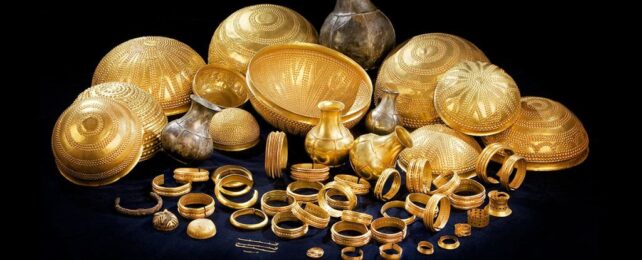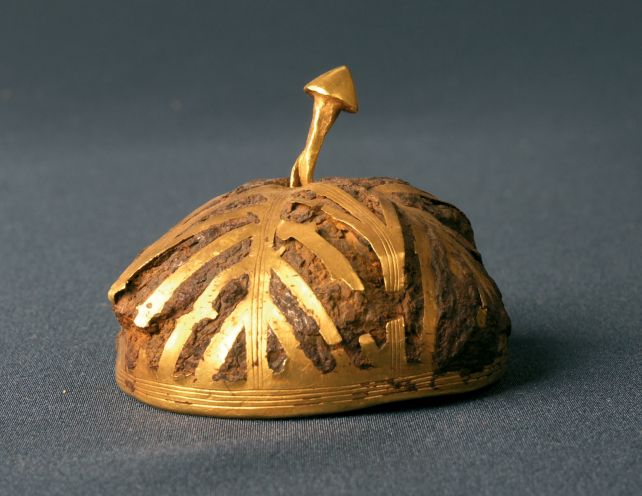by Kelly L.
November 8, 2024

Credits: Sunfire
Germany is going all-out to join the green hydrogen energy revolution with energy company RWE’s new 300 MW hydrogen gas production plant in Lingen in Lower Saxony. In the project’s third phase, companies Sunfire and Bilfinger were brought on board to get a 100 MW alkaline electrolyzer into operation, which is set to start producing hydrogen in 2027. Did you se a nuclear power plant on the image? Let’s take another look.
Groundbreaking gas plant will generate hydrogen for Europe
RWE’s Lingen hydrogen gas production plant is a major achievement not only for Germany but for the whole of the continent. The plant was commissioned to specifically supply industrial clients in Lower Saxony and the North Rhine-Westphalia regions, but there’s a bigger picture in mind. The production installation is also integrated with the European Hydrogen Backbone, a collaboration to make hydrogen accessible across Europe through an extensive network of pipelines. The network is targeted at areas with a high demand for hydrogen, such as major shipping ports or industrial centers, which will contribute significantly to the EU’s broader vision to reduce global greenhouse gas emissions.
The Lingen plant aligns with German and European Union climate targets, indicating the commitment to clean energy solutions for the long-term future. On a smaller scale, making hydrogen available to the average consumer empowers them with more sustainable options when purchasing vehicles, for example, enabling them to move towards fossil fuel alternatives.
Sunfire’s 100 MW electrolyzer set to start operating in 2027: It’s not a nuclear power plant
Sunfire, a German company specializing in fuel cell technology and high-temperature electrolysis, is working with RWE (Rheinisch-Westfälisches Elektrizitätswerk AG) to get the state-of-the-art 100 MW alkaline electrolyzer pumping out hydrogen gas by 2027. This is not the only form of hydrogen generation that the Lingen plant utilizes, but it will add significantly to the plant’s output and, therefore, the reach of the product. The installation comprises 10 ultra-efficient pressurized modules, each producing 10 MW of green hydrogen.
When the electrolyzer is completely operational in 2027, the plant’s output will be two tons of hydrogen an hour, going a long way to meeting Germany’s industrial and manufacturing demands and replacing greenhouse gas-emitting systems in the process.
How does an alkaline electrolyzer work?
Alkaline electrolysis is a chemically reactive process of producing hydrogen gas from electricity and water. An alkaline electrolyte agent, usually a potassium hydroxide (KOH) or sodium hydroxide (NaOH) solution, is needed to split the water molecules into hydrogen gas (H₂) and oxygen gas (O₂).
The Lingen plant’s 100 MW electrolyzer will be renewably powered by solar and wind energy, making the entire operation environmentally compliant. The hydrogen gas is mostly intended for various industrial applications in the region, making it possible for these operations to switch to clean energy, but some may be stored and transported further afield.
The advantages of hydrogen gas
The green energy revolution is sweeping the globe and technology is advancing at a phenomenal pace. Alternative fuels and sources of energy are a technological and developmental priority, especially in the transportation and manufacturing industries. All forms of hydrogen have a place in the race, and here are the benefits of hydrogen gas when used as a fuel:Efficiency: Hydrogen fuel cells deliver a high energy output compared to other kinds of fuels.
Versatility: Hydrogen gas can be used for heating, in vehicle powertrains, to create electricity, and to power machinery.
Environmentally safe: The only byproduct of hydrogen gas in fuel cells is water, making it one of the most environmentally friendly options to fossil fuels available.
Storage: Hydrogen is easy to store for long periods of time.
Contributions to the grid: Hydrogen can be utilized when other forms of renewable energy, such as wind or solar power, are not available.
It’s clear that Germany’s contribution to eradicating carbon emissions worldwide is a good example of how this can be carried out sustainably while promoting growth in the sector as a whole.
America fires up largest hydrogen generator in history: 3 tons per day in this state
by Kelly L.
November 10, 2024

Credits: SoHyCal
North America has cemented itself firmly in the green hydrogen game with the first operational plant in the United States. H2B2 Electrolysis Technologies owns the solar-powered hydrogen generator and has named the plant SoHyCal, alluding to its location in California’s Central Valley. The facility, which secured $3,96 million in funding, is expected to produce three tons of hydrogen each day, which will go a long way in the drive to eradicate carbon emissions and adopt clean energy.
November 10, 2024

Credits: SoHyCal
North America has cemented itself firmly in the green hydrogen game with the first operational plant in the United States. H2B2 Electrolysis Technologies owns the solar-powered hydrogen generator and has named the plant SoHyCal, alluding to its location in California’s Central Valley. The facility, which secured $3,96 million in funding, is expected to produce three tons of hydrogen each day, which will go a long way in the drive to eradicate carbon emissions and adopt clean energy.
SoHyCal unveiled as a pioneer of conservational hydrogen
The process of proton exchange membrane (PEM) electrolysis technology is used to produce conservational hydrogen from biogas with a capacity of three tons a day, which is the equivalent of a 100-vehicle fleet traveling around 3,000 miles each, which is about the same distance as driving across the entire United States—every day! Spanish company Ingeteam, which specializes in energy conservation and management, is competently in charge of the cutting-edge PEM system.
Pedro Pajares, CEO of H2B2 USA, promoted the project as an example to others:
“In the quest for a greener energy transition, SoHyCal represents a cornerstone in California’s commitment to developing and promoting clean and sustainable hydrogen fuel technologies. The project is poised to significantly contribute to the surging demand for hydrogen, particularly for transportation applications, the reduction of emissions, and the decarbonization in mobility.”
Renewable hydrogen produced by renewable energy
Conservational hydrogen supplier H2B2’s 100% renewably powered plant SoHyCal is ready to revolutionize the energy market and impact the transport sector, especially in North America. Not only does it produce hydrogen as a clean energy product, but the plant is also powered by photovoltaic energy generated in an integrated solar power system. This means that the entire operation is sustainable, from the energy used to the power produced.
Benefits for the State of California and beyond
California is firmly behind the carbon-free revolution, and its goals are reflected in the support extended to the development of the SoHyCal hydrogen fuel plant. Under its main goal, the Californian administration also wants to see hydrogen refueling stations installed across the San Joaquin Valley and San Francisco Bay areas. There are numerous types of vehicles capable of operating on hydrogen, including cars, trucks, and buses, that will soon depend on the supply network and justify the installation of the infrastructure.
Among other benefits, this will encourage more transport customers to transition from gasoline and diesel to responsibly sourced hydrogen, ultimately leading to decreased emissions and improved air quality.
Global standards for ecological hydrogen production
SoHyCal goes beyond being an achievement for North America, it also has global relevance. The Hydrogen Valley Platform (H2V), which is a global forum for sharing information about significant hydrogen projects, identified SoHyCal as a role model for hydrogen generation projects on other continents.
Hydrogen is becoming an increasingly attractive option for numerous industries as technology and performance advance, such as power generation, transportation, and industrial manufacturing. The market for hydrogen is expected to be worth $10 trillion by 2030, which puts H2B2 in a position to take a lead in the emerging market. China is another contender, with hydrogen production and export increasingly accounting for a portion of the Asian country’s GDP.
Benefits of hydrogen as a renewable fuel
There are several advantages of hydrogen in fuel applications:Zero emissions: The only byproduct that hydrogen fuel produces is water vapor.
Energy efficiency: This means more “value” derived from the volume of full, resulting in longer ranges.
Industrial applications: Hydrogen is ideal for high-power applications like manufacturing, aviation, and shipping, where batteries are not capable of delivering sustained periods of high-power output.
Fast refueling: Hydrogen tanks are faster to refuel than charging batteries in electric vehicles, taking about the same amount of time as gasoline or diesel vehicles. This makes it an attractive choice for long-distance transportation and public transport.
The time of hydrogen is rising, and the United States is rising with it as the world looks to clean fossil fuel alternatives.
Is hydrogen the fuel of the future?
By Johanna Gardener • Updated: 10 Nov 2024 • Euro Weekly News

Hydrogen production plant will hope to eventually provide hydrogen across Europe Credit: Shutterstock:Scharfsinn
Germany is showing its compliance with green initiatives as it turns on the most powerful hydrogen generator in Lingen, Lower Saxony.
The year 2024 seems to be leading the way in the push for a greener Europe and a more eco-friendly planet. With the promotion of hydrogen and electricity-fuelled vehicles, as well as new initiatives across many sectors to sustain our changing planet, baby steps towards global collaboration in protecting our planet appear to be advancing.
Germany is one country which is taking the question seriously. The country is going all-out to join the green hydrogen energy revolution. And it comes in the form of energy company RWE’s new 300 MW hydrogen gas production plant in Lingen in Lower Saxony.
What country is best for green hydrogen?
The hydrogen gas production plant is not only a significant achievement for Germany, but also for the rest of Europe. Despite the fact that the plant is currently only commissioned for specific supply in Lower Saxony and the North Rhine-Westphalia regions, forward-thinking plans include extending this further. The production installation is in-line with the European Hydrogen Backbone, which aims to make hydrogen accessible across Europe through an extensive system of pipelines. In order to control greenhouse gas emissions, hydrogen supplies will eventually be aimed at areas with high hydrogen demand including major shipping ports.
What does a hydrogen electrolyser do?
Hopefully, by 2027, the electrolyser will be fully operational and two tons of hydrogen an hour will be supplied. This matches demands for Germany’s industry and manufacturing sectors and, at the same time, meets requirements for eco-friendly regulations.
Many might be asking: What is an electrolyser and how does it contribute to hydrogen production? Alkaline electrolysis is a chemically-reactive process, whereby hydrogen gas is produced through a process involving electricity and water. An alkaline electrolyte agent – most commonly, a potassium hydroxide (KOH) or sodium hydroxide (NaOH) solution – is used to split water molecules into hydrogen gas (H₂) and oxygen gas (O₂).
Solar and wind power will power Lingen’s new electrolyzer ensuring that it operates fully via green systems. Although it will be supplied locally, clean hydrogen energy can also be stored and transported elsewhere.
What are the advantages of using hydrogen as a fuel?
Hydrogen gas is a bastion in the technological and developmental priorities listed on the EU’s agenda. It has numerous benefits including high efficiency and high energy output compared to other fuels. It can be used for heating, to create electricity and for machine power. More importantly, it is one of the most environmentally-friendly choices due to its only byproduct being water. Long term, it has a durable storage capacity and is a reliable source when other renewable energies like solar and wind energy are hard to come by.
Germany is clearly setting the trend for the rest of Europe: it shows us that whilst responding to the demands of industry and manufacture, countries can also mitigate the eradication of the carbon footprint.
Let’s hope that it serves as an example. Better still, that the whole of Europe can soon get a slice of the action!
By Johanna Gardener • Updated: 10 Nov 2024 • Euro Weekly News

Hydrogen production plant will hope to eventually provide hydrogen across Europe Credit: Shutterstock:Scharfsinn
Germany is showing its compliance with green initiatives as it turns on the most powerful hydrogen generator in Lingen, Lower Saxony.
The year 2024 seems to be leading the way in the push for a greener Europe and a more eco-friendly planet. With the promotion of hydrogen and electricity-fuelled vehicles, as well as new initiatives across many sectors to sustain our changing planet, baby steps towards global collaboration in protecting our planet appear to be advancing.
Germany is one country which is taking the question seriously. The country is going all-out to join the green hydrogen energy revolution. And it comes in the form of energy company RWE’s new 300 MW hydrogen gas production plant in Lingen in Lower Saxony.
What country is best for green hydrogen?
The hydrogen gas production plant is not only a significant achievement for Germany, but also for the rest of Europe. Despite the fact that the plant is currently only commissioned for specific supply in Lower Saxony and the North Rhine-Westphalia regions, forward-thinking plans include extending this further. The production installation is in-line with the European Hydrogen Backbone, which aims to make hydrogen accessible across Europe through an extensive system of pipelines. In order to control greenhouse gas emissions, hydrogen supplies will eventually be aimed at areas with high hydrogen demand including major shipping ports.
New hydrogen plant is compliant with European Union‘s climate targets
The Lingen Plant assimilates both Germany and the European Union’s climate targets for clean energy solutions for the foreseeable future. Making hydrohgen a feasible and available option for the average consumer is also a step in the right direction, especially when buying vehicles where non petrol or diesel vehicles are an alternative.
German company, Sunfire specializes in fuel cell technology and high-temperature electrolysis. Right now it is working with RWE (Rheinisch-Westfälisches Elektrizitätswerk AG) in a push to enable the revolutionary 100 MW alkaline electrolyzer to be ready by 2027 to pump out hydrogen gas. Lingen does have other forms of hydrogen generation, but this is an important addition for the plant’s output. Its installation is made up of 10 ultra-efficient pressurized modules, which individually produce 10 MW of green hydrogen.
The Lingen Plant assimilates both Germany and the European Union’s climate targets for clean energy solutions for the foreseeable future. Making hydrohgen a feasible and available option for the average consumer is also a step in the right direction, especially when buying vehicles where non petrol or diesel vehicles are an alternative.
German company, Sunfire specializes in fuel cell technology and high-temperature electrolysis. Right now it is working with RWE (Rheinisch-Westfälisches Elektrizitätswerk AG) in a push to enable the revolutionary 100 MW alkaline electrolyzer to be ready by 2027 to pump out hydrogen gas. Lingen does have other forms of hydrogen generation, but this is an important addition for the plant’s output. Its installation is made up of 10 ultra-efficient pressurized modules, which individually produce 10 MW of green hydrogen.
What does a hydrogen electrolyser do?
Hopefully, by 2027, the electrolyser will be fully operational and two tons of hydrogen an hour will be supplied. This matches demands for Germany’s industry and manufacturing sectors and, at the same time, meets requirements for eco-friendly regulations.
Many might be asking: What is an electrolyser and how does it contribute to hydrogen production? Alkaline electrolysis is a chemically-reactive process, whereby hydrogen gas is produced through a process involving electricity and water. An alkaline electrolyte agent – most commonly, a potassium hydroxide (KOH) or sodium hydroxide (NaOH) solution – is used to split water molecules into hydrogen gas (H₂) and oxygen gas (O₂).
Solar and wind power will power Lingen’s new electrolyzer ensuring that it operates fully via green systems. Although it will be supplied locally, clean hydrogen energy can also be stored and transported elsewhere.
What are the advantages of using hydrogen as a fuel?
Hydrogen gas is a bastion in the technological and developmental priorities listed on the EU’s agenda. It has numerous benefits including high efficiency and high energy output compared to other fuels. It can be used for heating, to create electricity and for machine power. More importantly, it is one of the most environmentally-friendly choices due to its only byproduct being water. Long term, it has a durable storage capacity and is a reliable source when other renewable energies like solar and wind energy are hard to come by.
Germany is clearly setting the trend for the rest of Europe: it shows us that whilst responding to the demands of industry and manufacture, countries can also mitigate the eradication of the carbon footprint.
Let’s hope that it serves as an example. Better still, that the whole of Europe can soon get a slice of the action!


 The Treasure of Villena.
The Treasure of Villena. 



 A ceremony honouring Alex Decoteau in Zonnebeke, Belgium. (Derek Haggett/CTV Atlantic)“I don’t have the words to say. It’s super heart warming to be here and the impact he’s had in the community is astonishing,” said Laforce.
A ceremony honouring Alex Decoteau in Zonnebeke, Belgium. (Derek Haggett/CTV Atlantic)“I don’t have the words to say. It’s super heart warming to be here and the impact he’s had in the community is astonishing,” said Laforce. Flowers are laid on Alex Decoteau's grave. (Derek Haggett/CTV Atlantic)Earlier in the day, Decoteau shared an incredible story about his ancestor’s death about a gold pocket watch which had been given to him from King George V.
Flowers are laid on Alex Decoteau's grave. (Derek Haggett/CTV Atlantic)Earlier in the day, Decoteau shared an incredible story about his ancestor’s death about a gold pocket watch which had been given to him from King George V.


 \\\\\\\
\\\\\\\




